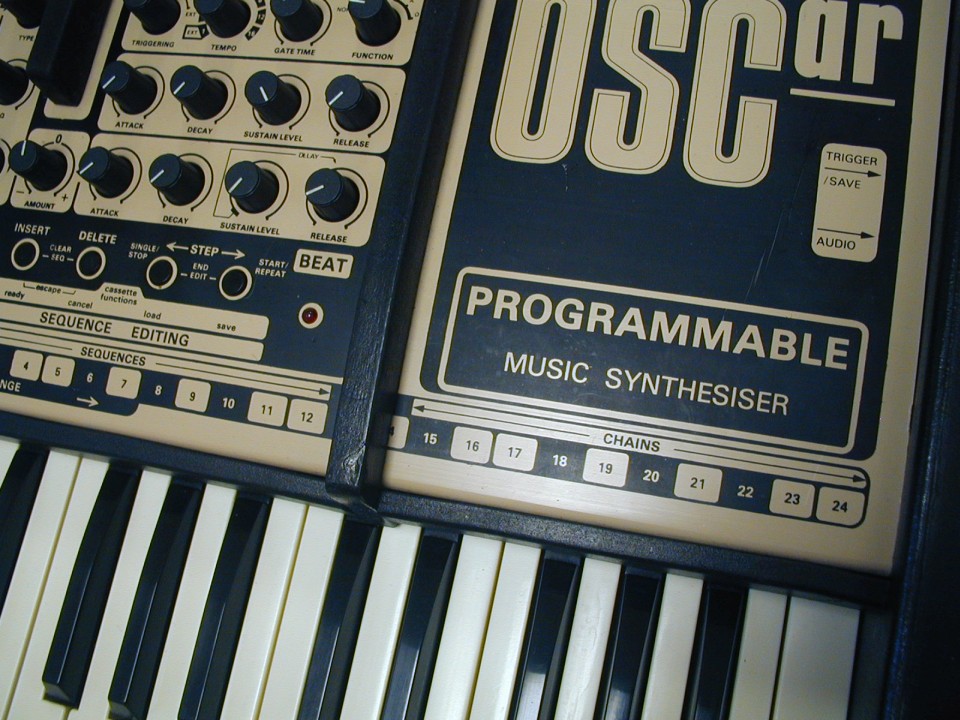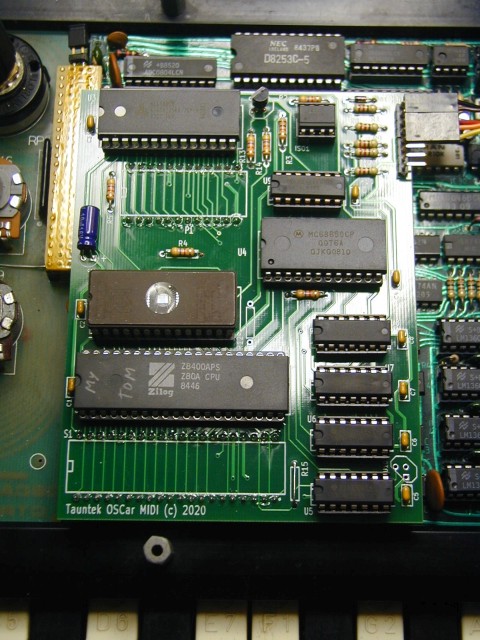Oxford Synthesizer Co OSCar

Someone contacted me recently asking if I would be interested in possibly making some additions to the OSCar firmware. I knew nothing about the OSCar, but decided it would be interesting to learn about it.
First, some new schematics:
Having easy to read schematics which accurately reflect the production units is a great asset, both for learning how things work, and for doing any repairs. Since the only schematics that seemed to exist for the OSCar (except the filter section) were scans of hand-drawn ones, I decided to enter them into a schematic capture program and make them available to others. I checked all of them except the filter and vca sheet against an OSCar with V1.3 boards that I was able to borrow for this project. Here is an archive containing them. Use them at your own risk. Please let me know if you find any errors. Another OSCar owner sent me photos of his processor board, and I could see that some of the resistor values were different from those on the board that I have. I have indicated these on the schematics.
Replacing a faulty rotary switch:
Replacing switches and potentiometers in synths from the 1980's can sometimes be tough, as the parts are no longer made and very hard to find. But in the case of the OSCar rotary switches, luckily, this is not the case. These switches were made by Lorlin UK, and are still available. A single-pole twelve position switch was used. This switch has an adjustable stop to set the number of available positions. For the OSCar, this would be set to give six positions. A single pole switch should be used, as pcb traces are routed through the unused pins and these should not be connected to anything. The mfr part number is CK1044, and the Mouser part number is 10WA144. The plastic shaft is longer than the exact part that was used in the OSCar, so you will need to cut off the excess. I used a hack saw for this, after covering the switch itself with tape to prevent any loose plastic bits from getting inside.
Fixing another issue:
The S&H timing around the DAC in the OSCar is pretty tight. The DAC output needs to settle quickly after new data is applied to it, so that the voltage can be sampled and held properly. To accomplish this, a wide bandwidth LF357 op amp with a fast slew rate was used to convert the DAC's current output to a voltage. I was trying to repair an OSCar recently which had noise in both oscillator waveforms all of the time. When I looked at the DAC output voltage waveform with my oscilloscope, I could see that it was changing a lot more slowly than it should have. As a result, the DAC had not settled to the new value by the time its voltage was sampled for the oscillators. I could see that the LF357 op amp had been replaced at some point. It seemed likely that the replacement chip, also marked "LF357" was counterfeit, and was in fact an inferior (slow) garden-variety op amp. When I replaced this op amp with a different LF357, the DAC changes were much faster, and the noise was gone. Or so I thought... Turns out that I was still getting a very small, just barely audible amount of feedthrough from the S&H updates into the oscillator waveforms. The timing in this part of the circuit is pretty tight. I was getting a glitch of about 500 mV on the osc 1 waveform when the S&H update occured. It was a very short glitch, on the order of a microsecond in length, so it just added noise to the oscillator that could only be heard by turning off the oscillator waveform, and turning up the volume. When doing this, it was easy to hear the noise. I ended up reducing it dramatically by replacing IC26 with a new TI CD4053BE. Maybe the Toshiba chip that I removed was failing, or perhaps the timing simply wasn't correct for this circuit. The date code on the Toshiba part was 1988, so it was not the original chip.
OSCar firmware version with arpeggiator issue:
Some OSCars have an issue affecting the Up mode of the arpeggiator. The lower keys of the keybed are not arpeggiated. This issue seems to have been introduced when the M2 version of the firmware was edited to preserve the MIDI channel and MIDI settings when the synth is powered off. It seems that when these changes were made, the arpeggiator bug was also introduced. One version of the code that has this is called "M2PLUS". Probably copies were made of this firmware, or possibly it was based on some other version that had the same bug. If your OSCar's arpeggiator doesn't seem to work properly in the Up mode, see if the MIDI channel is preserved when power is off, and also the MIDI settings. If they are preserved, then you may have this version of the firmware in your synth. Even if these settings are not preserved when power is off, this kind of arpeggiator behavior is almost certainly a firmware issue.
New OSCar MIDI board:
The M2 OSCar MIDI firmware EPROM is completely full. There is no room for any new code. Simply plugging a larger EPROM into the same socket would not increase the available space, since the CPU address decoding would also need to be changed to allocate more space to the EPROM. To accomplish this, I designed a new version of the OSCar MIDI daughter board. It mounts a little differently from the older ones, but is compatible with the OSCar processor board. I am planning to offer bare boards, but will not offer assembled boards. Here is a photo of the new board:

The above photo shows the first version of the new MIDI board for the OSCar. I am currently offering a second version, which supports wiring a Lithium battey directly to the MIDI board, so that the NiCAD one can be removed. Here is the list of parts needed to build the v2 MIDI board. And here is the v2 component placement diagram. Here and here is some additional information about assembling the v2 MIDI board. Here is the documentation for the first version of the MIDI board.
New firmware for the OSCar:
With the help of a number of brave OSCar owners, I have developed an enhanced version of the OSCar MIDI firmware. It can only be used with the new MIDI board, since the old EPROM was completely full.
Here are the new features:
1) MIDI channel and MIDI settings preserved when power is off
2) RAM is checked and initialized if contents have been lost.
Factory
patch bank is loaded
3) MIDI CC reception added for all front
panel controls except volume
4) LFO modulation to Osc 1 can be
disabled/enabled. Setting saved in patch
5) LFO waveform can be
reset when Arp or Sequencer is clocked to next note.
Setting saved in
patch
6) Three new PWM rates added. One faster and two slower.
Setting saved in patch
7) MIDI note velocity can be used to
control filter envelope amount along with pot
8) Any one of three
sets of patches can be loaded from EPROM. One set is thought
to be
the factory patches. The other two sets contain recently-created
patches.
9) Current set of patches can be saved in one of two RAM
"save areas" and recalled later.
This could be used either as fourth
or fifth sets of patches to load, or places to save
user patches
before loading the EPROM ones.
10) New random ARP mode added.
Plays pressed or "held" keys in a random order.
Order is constantly
updated. Keys may repeat before all other keys have been
played.
Keys may also play twice in a row.
11) Current patch can be saved
to the location that it was loaded from, by pressing
Voice Store
Key0. Pressing Voice Key0 still selects the panel.
12) Patch
selected most recently is loaded at power-up, instead of Patch 1
13) Patch 6 is no longer selected automatically when sequence editing is
started
14) CC dump of patch parameters after patch selection can
be enabled or disabled
using control keys. CC dumps are disabled
during sequencer payback
Here is a document which shows what CC numbers are assigned to different parameters. Here is a photo that shows the control keys added to control some of the new features.
Here is an archive which contains the new firmware EPROM image and documentation. This is provided for non-commercial use only.
And now the bad news:
Working on an OSCar is more difficult than many other 1980's synthesizers, due to several factors. Just getting it apart is a bit of a challenge. Many OSCars have been modified over the years to improve the reliability of the connections between the processor and control boards. Many people have replaced the connectors with 23 short jumper wires. (I am not suggesting that you do this, but the original connectors do tend to cause issues over time) Also, the way the original MIDI board connected to the processor one was not as reliable as some other methods, so many OSCars have been modified in this area as well. This makes installing a new MIDI board more complicated, because you first need to see how the existing board is mounted, and then make some decisions. The copper traces on the OSCar processor board are smaller, and more easily lifted up than on some other boards, so any soldering work on this board should only be done by someone with lots of experience soldering, or the board will most likely be damaged. Another factor which makes mounting the new MIDI board more challenging is that the space between the processor board and the underside of the top cover is just barely enough to fit the MIDI daughterboard. So the connectors used between the boards must be just high enough so that the MIDI board does not touch the components on the top side of the processor board, but not so high that the top cover pushes down on the MIDI board.
Several people's OSCars no longer functioned when they first
installed the new MIDI board. Luckily, they were able to get
them going again. The point is that it's not a simple
upgrade.